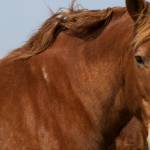Cryotherapy for Avoiding Laminitis in At-Risk Horses

A sudden increase in carbohydrates—either by accidentally ingesting large amounts of concentrates or overindulging in lush pastures—can contribute to the onset of laminitis. As such, horse owners go out of their way to limit carbohydrates. Other causes of laminitis can’t be avoided as easily. Take, for example, supporting-limb laminitis that occurs following an injury in one limb.
“The nutritional management of horses prone to laminitis plays an important role in minimizing the severity of this painful, life-threatening disease,” noted Kathleen Crandell, Ph.D., a nutritionist for Kentucky Equine Research.
Overweight, easy-keepers predisposed to chronic or recurrent bouts of laminitis and horses with either metabolic syndrome or Cushing’s disease serve as great examples.
“Such horses should be maintained on diets low in soluble carbohydrates, also referred to as nonstructural carbohydrates,” Crandell advised. “This involves limiting pasture intakes, selecting hays low in water-soluble carbohydrates, or soaking hay to remove some of the sugar, and balancing the diet with a ration balancer or vitamin and mineral supplement when needed. Replacing conventional concentrates with feeds high in fiber and fat is also recommended.”
Supplements such as Bio-Bloom PS (Bio-Bloom HF in Australia) contain key nutrients, including biotin, methionine, iodine, and chelated zinc, to help improve hoof growth and strength.
Despite the best intentions, some horses will continue to founder. In such cases, cryotherapy, the intense and prolonged cooling of the lower limb and hoof, can help in successfully managing these patients.
Traditional cryotherapy involves either submerging affected hooves in ice-cold water or purchasing a specialized boot that circulates cold water and applies compression to the foot. Together, these techniques are referred to as “wet” because they require water to achieve cooling.
While effective, wet cryotherapy has drawbacks. As described in a recent study*, wet cryotherapy is labor-intensive, as treatment should continue until 24 hours after resolution of clinical signs. Anecdotal reports of cellulitis, local tissue damage, and softening of the hoof following submersion exist.
In an effort to alleviate these concerns, a novel “dry” cooling system was devised. The system, currently available commercially, includes reusable and moldable cold therapy packs and a specially designed boot to hold the packs in place.
“The dry cryotherapy system successfully decreased hoof surface temperature compared to the untreated control limbs, and achieved temperatures below the recommended target of 50° F (10° C),” relayed Crandell.
Do you have a horse or pony prone to laminitic flare-ups? Puzzled by how best to feed him? The nutrition advisors at Kentucky Equine Research are available for consultation. Ask now!
*Morgan, J., D. Stefanovski, M. Lenfest, et al. 2018. Novel dry cryotherapy system for cooling the equine digit. Veterinary Record Open 5(1):e000244.








